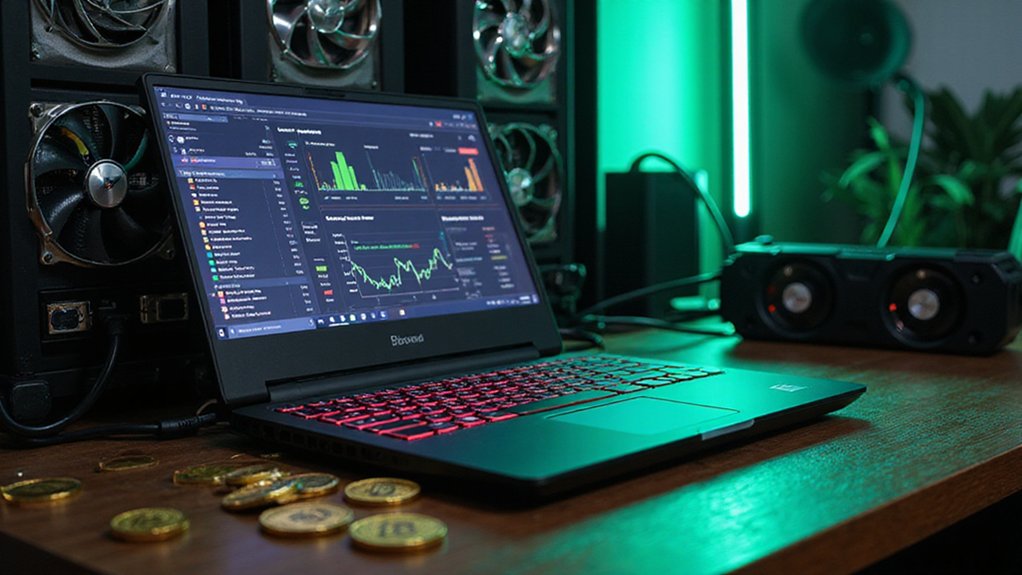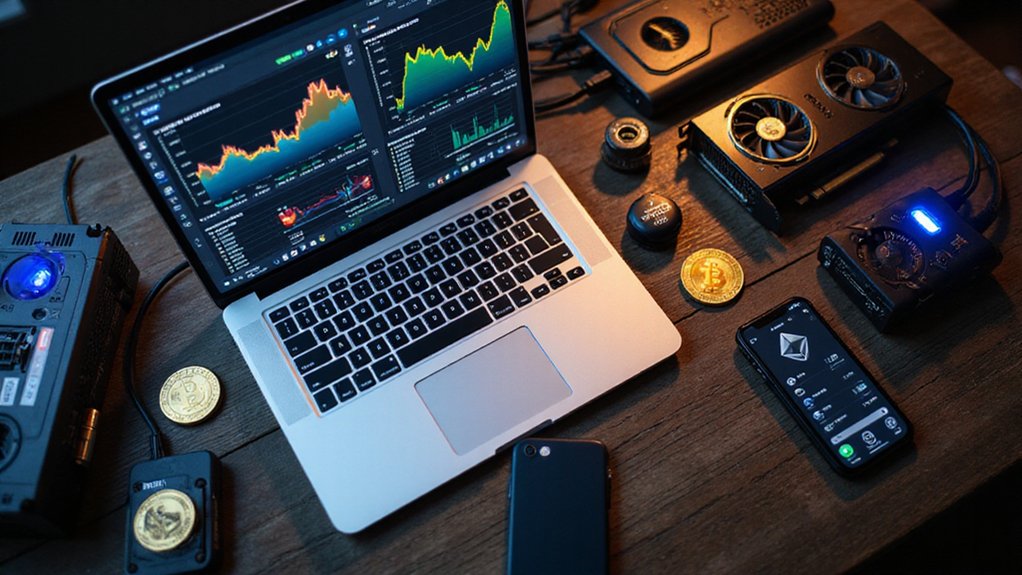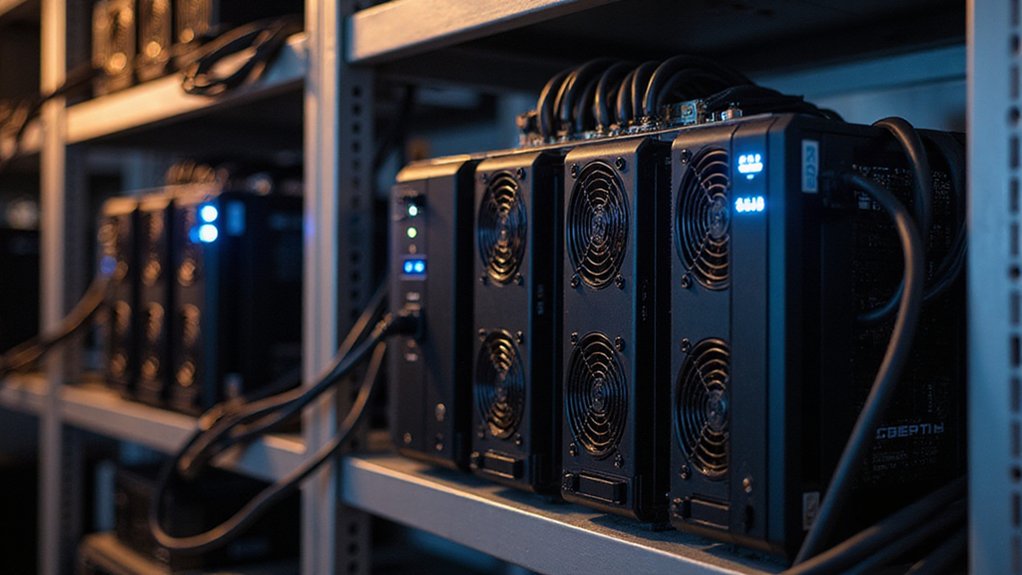EasyMiner and MultiMiner lead the pack for cryptocurrency novices in 2024, offering graphical interfaces that mercifully eliminate command-line nightmares while supporting both GPU and CPU mining across multiple platforms. Kryptex Miner provides Windows-optimized GPU mining, though one might question whether smartphone apps like HEXminer truly constitute “mining” given their laughably modest returns. Cloud platforms like ECOS remove hardware headaches entirely, trading control for convenience—a bargain many find irresistible despite inherent risks that warrant deeper examination.

While seasoned cryptocurrency miners debate the merits of custom firmware and overclocking protocols, newcomers to the digital mining frontier face a more fundamental challenge: selecting software that won’t require a computer science degree to operate. The landscape of beginner-friendly mining applications has evolved considerably, offering graphical interfaces that transform what was once an exercise in command-line mastery into something resembling conventional software usage.
EasyMiner exemplifies this democratization, providing a graphical interface that supports both GPU and CPU mining without demanding coding expertise. Its military-grade security features (a marketing phrase that somehow survived the shift from defense contractors to cryptocurrency software) protect mining operations while maintaining accessibility.
MultiMiner extends this user-friendly approach across platforms, supporting Windows, macOS, and Linux while incorporating automatic coin switching—a feature that optimizes profitability without requiring constant market monitoring.
For those gravitating toward GPU-focused operations, Kryptex Miner delivers automated optimization through a Windows-based interface, though significantly excludes ASIC hardware support. This limitation reflects a broader trend where beginner software prioritizes accessible hardware over specialized mining rigs.
Conversely, Awesome Miner accommodates multi-rig management but ventures into intermediate complexity territory, illustrating the persistent tension between functionality and simplicity.
Cloud mining presents an alternative pathway through platforms like ECOS, which eliminates hardware ownership requirements entirely. Mobile mining apps such as HEXminer provide another low-maintenance option for beginners who prefer smartphone-based mining solutions over traditional desktop software. This approach trades direct control for convenience, allowing beginners to participate through investment rather than technical implementation—though service fees and associated risks warrant careful consideration.
The profitability equation remains unforgivingly complex, influenced by energy costs, mining difficulty, and market volatility. Pool mining through beginner-friendly software increases payout frequency compared to solo mining attempts, which often prove futile for novices lacking substantial computational resources.
Advanced profitability tracking features help beginners navigate these variables, though the underlying mathematics remain as unpredictable as ever.
Software selection ultimately depends on hardware ownership, budget constraints, and technical aptitude. While intuitive dashboards and step-by-step wizards reduce entry barriers, the fundamental challenge persists: transforming electricity and computational power into digital assets within an increasingly competitive ecosystem where success often hinges on factors beyond software choice.
Frequently Asked Questions
How Much Electricity Does Crypto Mining Consume Monthly?
Cryptocurrency mining’s monthly electricity consumption reveals staggering figures that would make utility executives simultaneously weep and rejoice.
U.S. operations alone devour 2.1 to 7.6 terawatt-hours monthly—equivalent to powering three to six million homes.
Globally, Bitcoin mining consumes 6.7 to 32.5 TWh monthly, representing roughly 0.5% of worldwide electricity demand.
These fluctuations depend on price volatility and mining difficulty adjustments, creating an energy consumption pattern as unpredictable as crypto markets themselves.
Can I Mine Cryptocurrency on My Smartphone or Tablet?
While smartphones can technically run mining applications, the reality proves rather underwhelming.
Mobile devices lack the computational horsepower for meaningful returns—particularly given the electricity consumption discussed previously.
Most “mobile mining” apps employ lightweight consensus protocols (Pi Network’s social mining) or cloud-based services where phones merely serve as management interfaces.
True mining on tablets remains economically questionable, yielding pennies while potentially degrading hardware through heat and battery strain.
What Are the Tax Implications of Crypto Mining Rewards?
Mining rewards trigger immediate taxable events at fair market value upon receipt—regardless of whether miners actually sell their digital treasure.
The IRS treats these rewards as ordinary income (taxed up to 37%), requiring meticulous record-keeping of dates, amounts, and valuations.
Subsequent sales generate capital gains based on the difference between original mining value and disposal price, with holding periods determining short-term versus long-term treatment.
How Long Does It Take to See Mining Profits?
Mining profitability timelines stretch from several months to over a year, contingent upon hardware efficiency, electricity costs, and network difficulty adjustments.
Small-scale miners typically earn Bitcoin fractions daily, making break-even calculations particularly sobering when factoring $2,000-$20,000 equipment investments against current 3.125 BTC block rewards.
Market volatility compounds uncertainty—yesterday’s profitable operation becomes tomorrow’s expensive hobby when prices plummet, rendering those carefully calculated ROI projections rather optimistic exercises in wishful thinking.
Is Crypto Mining Legal in My Country or State?
Crypto mining legality varies dramatically by jurisdiction—Georgia offers zero capital gains taxes while Russia permits international mining but bans domestic use.
The EU’s unified MiCA framework legitimizes operations across member states, though local regulations often impose additional licensing requirements.
Given that some nations treat cryptocurrency as neither currency nor asset (a fascinating regulatory limbo), miners must research both national and regional laws before commencing operations.









